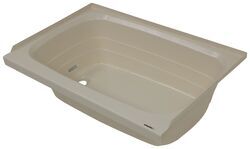
What is Needed to Install a New Alcove Bathtub in an RV or Trailer
Question:
What parts do we need to install new tub
asked by: Marcia H
Expert Reply:
Besides the tub itself, such as # LC209372, you may need some new plumbing if the old plumbing gets damaged during the removal process for the old tub. You could reuse the drain that you have but new ones can be found anywhere plumbing stuff is sold. The basic Installation instructions are as follows.
Note: All caulks, adhesives, sealants MUST be compatible with ABS.
1. To avoid damage to apron, stand pan on side to install strainer.
2. Install strainer – excessive tightening of lock ring is not required and could cause damage to drain area. Do not use sharp object to remove excess caulk from around top of strainer.
3. Construct alcove with proper placement and construction of:
A. Access Hole: The size and shape may vary according to individual manufacturer. The access hole should be cut as small as possible to allow full support of the pan foam bottom at drain area. (1-1/2” of pan foam bottom extending over access cutouts is acceptable).
B. Threshold Support (if applicable): The front of the pan is to be supported. Material for construction should not exceed 1-1/2” overall thickness. (Note: Do not exceed 2-1/4” on 3548 and 3560 Pans.)
4. Set pan in place. Ensure bottom foam support sets securely on floor. Areas of importance are:
A. Floor MUST be flat, level, and solid.
B. Apron is set properly into “F” strip.
C. Threshold support at proper height.
Note: If shim is used for proper floor contact, it should support the entire foam base of pan. Partial shims should not be used and pan should be level for proper drainage.
5. Secure pan to walls using flat-back non-rusting screws. It is suggested that pan not be secured until the alcove walls are in place and secured. Ensure alcove walls are plumb, straight, and square before securing pan flanges. Flange stress, bowl deflection, and/or bottom deflection can result from moving or repositioning a wall with the pan partially attached.
6. Flat-back non-rusting screw method;
A. If wall does not touch flange, a shim should be used to prevent flange distortion.
B. Pre-drill oversized hole for screws
C. Stand in pan while installing screws.
D. Use flat-back non-rusting screws
E. Use only two (2) screws per flange
F. Screws are to be inserted 90 degrees to the wall in center of flange.
G. Do not screw through corners (minimum 3” from corners).
H. Tighten the screw until the screw back touches the flange and stop. Do not over tighten so as to distort/stress the flange.
7. Connect drain line to pan strainer after installation is complete. P-trap should connect to strainer or tail piece without requiring force or causing back pressure to drain line.
8. Clean properly. Do not use any non-recommended cleaners (see “Care and Cleaning Instructions”).

Product Page this Question was Asked From
Better Bath RV Bathtub - Left Hand Drain - 36-1/8" Long x 24" Wide - Parchment
- RV Showers and Tubs
- Bathtub
- Tubs
- 11-1/8 Inch Tall
- Off White
- Lippert
more information >

Continue Researching
- Shop: LaSalle Bristol RV Shower Drain w/ Grid Strainer - 1-13/16" Diameter - Chrome
- Shop: Valterra Threaded RV Sink Drain - Fits 1-3/4" Diameter Drains
- Shop: LaSalle Bristol P-Trap Adapter for RV Sewer System - ABS Plastic - 1-1/2" Hub
- Q&A: What Shower Trap Does Valterra Shower Drain A01-2012VP Work With
- Q&A: Does Valterra Shower Drain A01-2012VP Fit 1-1/2 inch P Trap Application
- Q&A: P-Trap Fitting For A Shower/Tub That Has A 1-1/4 Diameter Pipe
- Q&A: Availability of Shower Drains for Better Bath RV Shower Pan
- Video: Review of LaSalle Bristol - RV Sinks - 34433JN1202
- Video: Review of LaSalle Bristol RV Sewer - Connectors and Fittings - 344633211X
- Shop: UniGuard Waterless P-Trap for RV Sewer Systems - 1-1/2" FPT - ABS Plastic - White
- Article: Trailer Wiring Diagrams
- Search Results: shower pan
- Shop: Trailer Hitch
- Search Results: maxxair
- Shop: Suspension Enhancement
- Article: RV Sway Control, Stabilization, and Suspension Enhancement
- Shop: Camco RV Drain Trap for 3/4" Diameter Drain Hose
- Shop: MaxxFan Deluxe Roof Vent w/ 12V Fan and Thermostat - Manual Lift - 10 Speed - Smoke
- Search Results: distribution panel
- Article: Trailer Tire Sizing
- Shop: RV Interior Lighting
- Article: Brake Controller 7- and 4-Way Installation Kit (ETBC7)
- Shop: MaxxFan Plus Roof Vent w/ 12V Fan, Thermostat, and Remote - Powered Lift - 10 Speed - Smoke
- Search Results: water pump
- Shop: Fifth Wheel Hitch
- Search Results: furrion
- Shop: Trailer Wiring
- Search Results: shower drain
- Shop: Brake Controller
- Shop: Gooseneck Hitch




